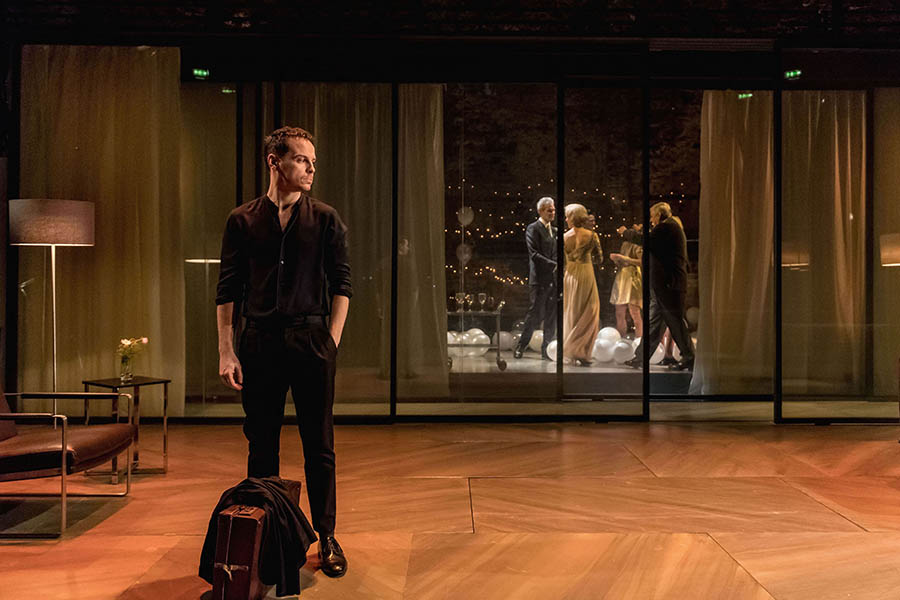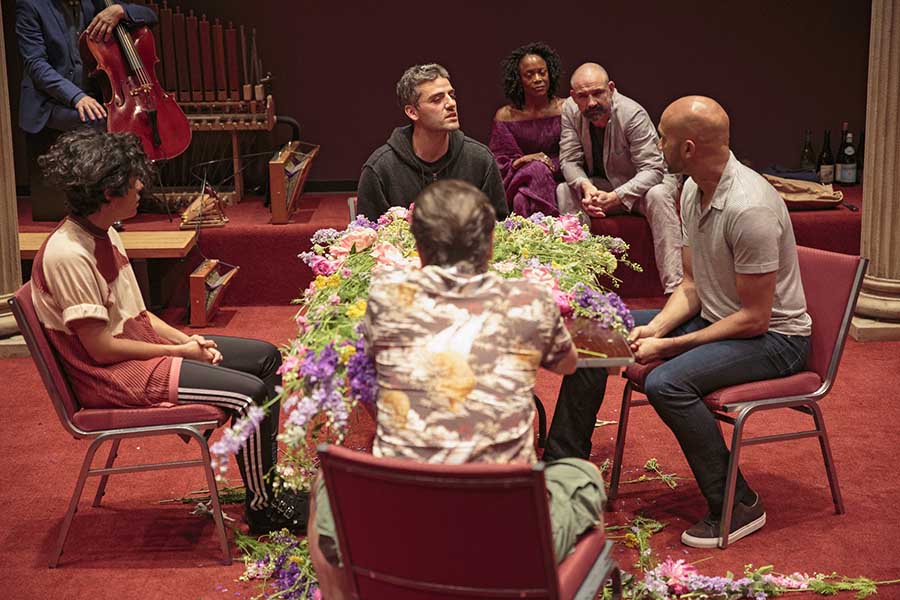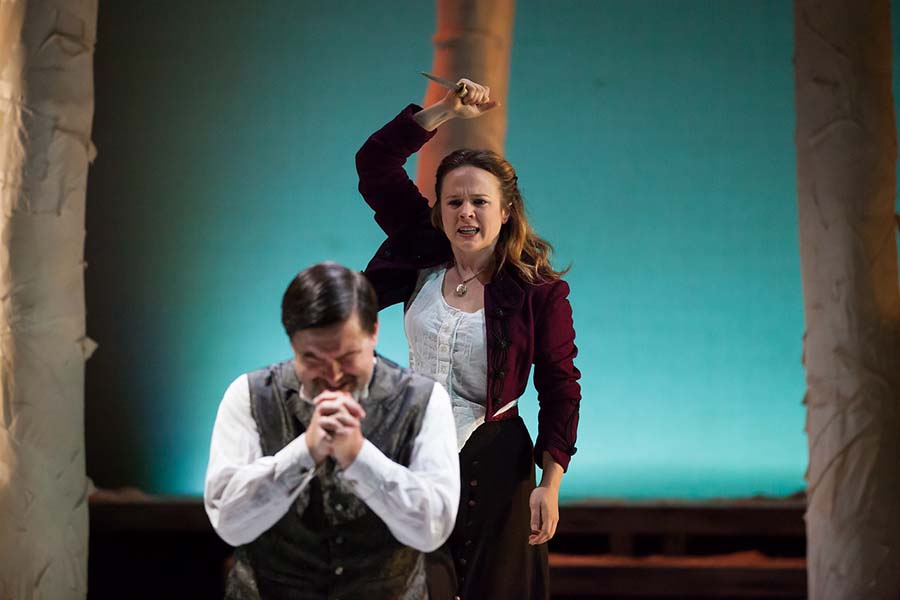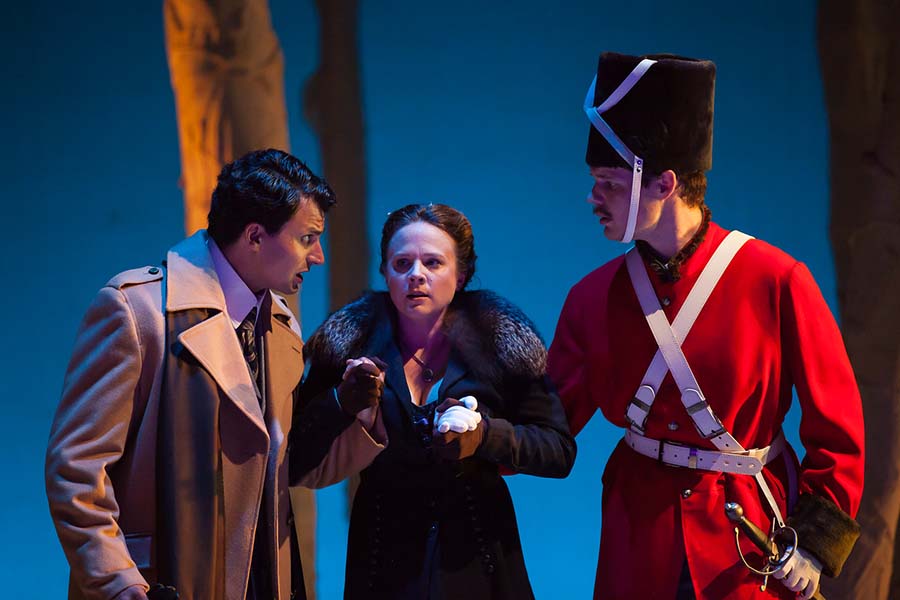When I set out to experience a summer of Hamlets, I knew all the Hamlets would die, but I did not know how they might live and how the three productions I attended would feel seen in succession. Ever since I was 15, when I saw Mark Rylance haunt the halls of Elsinore in his pajamas, I’ve been chasing Hamlets.
I was drawn in this time by the prospect of seeing two wunderkind directors step into the fray: Robert Icke in London and Sam Gold in New York. Adding to the intrigue: Carolyn Howarth casting a woman as Hamlet at Colorado Shakespeare Festival.
Three cities, two countries, one missed flight, and 11 hours of theatre later, I’d seen top-tier artists wrestle with a 400-year-old text in wholly surprising ways. From these three very different directors I learned that this play has a lot more to show me.

Robert Icke’s production, which closed last weekend on the West End, ranks as one of the most clear, deliberate, and sharply drawn I’ve ever seen. It felt like watching a beautiful bird soar, sing, and be smothered before our eyes. And Andrew Scott’s melancholy Dane was the first Hamlet I’ve seen to rival my memory of Rylance’s.
Icke established a world dominated by a 24-hour-a-day news cycle, with the Danish royal family frequently filmed and reports given from the Norwegian front about Fortinbras; the King’s Ghost appeared via surveillance monitors. But this was no conceptual gimmick. Instead these choices established a present-day frame for the politics and characters of the play. In addition, the primary set’s chrome, mid-century modern design felt timeless but recognizable. Familiarity bred empathy. The scale of the family drama was quite human.
Icke expanded his playing field, with layers of frosted glass walls dominating the design. These allowed him to double scenes: Polonius and Ophelia could speak to one another downstage, for instance, while a party continued behind them in the next room. Interactions took place just out of Hamlet’s audible reach. People could observe each other without knowing all. Icke and designer Hildegard Bechtler made palace intrigue literal.
For all the smart directorial choices, the linchpin was Scott. He brought no ego to his performance. He wasn’t acting out Hamlet, he was Hamlet: a fallible man thrust into a scenario he cannot control. It would kill him, and we were there to watch.
Every word sprang naturally from Scott as he ruminated upon them. He was present in every moment. Even as the play moved swiftly, Scott took his time and let Hamlet’s sadness slowly unfurl. It gave way to anger and madness. There wasn’t an extraneous gesture or pontificating oration. Scott’s contemplation of Hamlet’s teary-eyed grief, anguished indecision, and pained helplessness made for heartbreaking drama.
Icke also offered us an Ophelia we can understand. In a few extra-textual scenes of Hamlet and Ophelia (Jessica Brown Findlay) fooling around early on in the play, we saw their affection before things fell apart between them. Later Ophelia greeted Hamlet from her bath; he was first kind, then violent. His duplicity wounded us as it did her. When she ran to tell her father about what had just happened, we’d seen it for ourselves. We knew her truth.
Adding texture to Hamlet’s fraught relationships with women, Guildenstern was cast as a woman (Madeline Appiah). The warmth she and Hamlet shared even suggested a past dalliance, which subtly complicated Hamlet’s growing distrust of Rosencrantz and Guildenstern. His love, affection, and friendships were at war with his more urgent intentions to uncover his father’s murder.
Indeed, Scott took great pains to show how each cut Hamlet made toward others hurt him twice as much. He cried as he denied his love to Ophelia. He kissed her and threw water at her during their “nunnery” confrontation. Wounding her, he was wounded anew, and that anguish rubbed off on us.
Icke’s most dramatic choice came in the finale. Where we might have anticipated a bloodbath, he focused instead on a moment beyond all the violence. Without giving away too much, let’s just say: We were startled and undone by the gentleness. As we’d seen all along in Icke’s production, these characters were not icons but humans.
In short, nothing Icke did was inevitable or expected, and the play felt reborn.

At the Public Theater, Sam Gold likewise shed all vestiges of a traditional Hamlet, though his production (also just closed) felt more unconstructed than deconstructed—beautifully recited, but “performed.” While the actors were strong, the direction was baffling.
Throughout the production belied the self-awareness of putting on a show. With a cast of nine, Gold doubled and tripled roles, sometimes to point of maddening confusion. We were bludgeoned with the nature of performance and artifice. While those ideas certainly sprang from the text, the production rarely found a way to make these concepts blossom into something richer.
The set design evoked a function room, with burgundy industrial carpet, silver cylindrical hanging lights, a folding table, cut flowers, and a lone musician. It mirrored the Public’s Anspacher theatre itself (also burgundy seats and carpet). There were thus no “theatrical” boundaries: The actors sat on the stage or on the aisle steps after their scenes were done. Scene transitions were visible, with actors setting scenes, breaking character, or trotting off to the sidelines to observe. But the role of the audience in this space was ill-defined. All this casualness drifted into loose intention.
Brooding in his hoodie and sweatpants or gamboling in gray briefs while playing mad, star Oscar Isaac was a similarly adrift, undone Hamlet. Gold carefully avoided any objectification of the Hollywood heartthrob; there was nothing sexy about this pantsless Hamlet with a toilet seat cover dangling about his neck.
Gold also removed all the Fortinbras material, stripping away the politics and the source of Hamlet’s aspirational ambitions. The result was a Hamlet who never rallies to confront his inner demons. This Hamlet’s biggest achievement was to stab a lasagna (it made several appearances, and I would argue it was the 10th player in the ensemble). He laughed at his own ridiculousness as he knelt above the defeated meal.
On the plus side: Isaac spoke his lines with a relaxed cadence. Whether teasing Polonius (the pitch-perfect Peter Friedman) or trading barbs with the grave diggers, Isaac excelled with the lighthearted mania his Hamlet adopted and the sharp comedic asides he delivered. But a lethargy hung over scenes of Hamlet’s melancholy, and Gold never found a way to make these critical moments resonate. The self-awareness he foregrounded frequently undermined the emotion.
And yet Gold painted a singular haunting image in Ophelia’s drowning. After Ophelia (an assertive, sarcastic Gayle Rankin) uprooted some potted plants, she packed the soil upon the dead Polonius, ceremoniously laid out on the stage. She brought a garden hose into the room. Soaking herself first, she then curled up next to her father’s body, as the hose poured water upon them and the mix coagulated into rivulets of mud. Gold gave a moment of silence and stillness for us to breathe in this image. Then both actors sprang upright—and become the two grave diggers giddily playing in the dirt. The doubling here worked, though it again highlighted the artifice of performing. No one was really dead; grief was a trick, woe now a frivolity.
I longed for the laughter to yield at times to the pathos.

Carolyn Howarth’s female-centric Hamlet, which ran through mid-August in Boulder, Colo., shared with Gold’s a certain froth. Setting the piece in the early 20th century, Howarth directed it with a breathless pace. Also like Gold, she struggled to get this buoyancy to serve the tragedy. But though the production faltered in its second half, I was with star Lenne Klingaman the entire time.
Klingaman’s Hamlet was feisty, intelligent—think Anne Shirley in a snow-covered forest. Howarth leaned on Klingaman to play Hamlet’s madness as jovial, but she managed, like Andrew Scott, to live the complex duality of Hamlet. Particularly in her “nunnery” scene with Ophelia, she knew she was being observed by Polonius (Howarth uses menacing projected shadows). Hamlet had to prove to these spies that she was mad, but being outwardly cruel to Ophelia tore her asunder.
As joyous as her comedic scenes were, Klingaman also found fine shading in Hamlet’s self-doubt. Her soliloquies were pensive self-examinations—a woman preemptively arguing with herself before anyone else could challenge her on her choices.
Indeed, Hamlet’s conflict with herself and the world just sits slightly differently when the prince is a woman. It gave a subtle, significant undertone to the production. Who knew: Gender shifts our perspective. The way people interacted with the “mad” prince, or eyerolled at her antics, or worried about her, here carried a frisson of gendered social considerations. It had the effect of happily shaking us from our expectations without undermining the work.
Laertes and Fortinbras were also women in this production, which meant gender did not cloud these personal and political rivalries; the textual intentions remained intact. That this lady Hamlet loved Ophelia similarly upended nothing in the text—all the more reason for this casual queerness. And a female Hamlet softens some of play’s woman-bashing: Hamlet arguing with her mother is less about patriarchal control and more about their relationship and their conflicts over loss and grief.
These are all welcome changes. Howarth and Klingaman managed to crack open the play in a new way for me by putting Shakespeare’s words, written for historically male characters, into the mouths of women and giving them a chance to speak.
These three stagings had little in common except this: All demonstrated that Hamlet need not be treated as a historic relic to be declaimed in codpieces. Grief, rage, frustration, and inertia are not the exclusive remit of Elizabethan England—or of men, for that matter. Among the things Hamlet‘s perpetual relevance ensures: My own lifelong search will surely continue.
Nicole Serratore is a writer, theatre critic, and attorney based in New York City. Her work has appeared in The New York Times, Village Voice, The Stage, Exeunt magazine, and other outlets.


